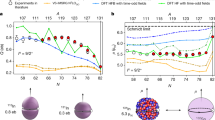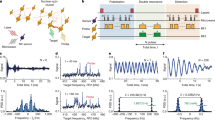Abstract
Quadrupolar nuclei are the most abundant nuclear magnetic resonance (NMR)-receptive nuclei in the Earth's crust, and in many amorphous materials of technological interest (such as zeolite catalysts, ceramics and alloys), and have thus been intensively studied1–7. Of particular interest is the ability to resolve and quantitate the various types of sites present in a given material. Here we present a very simple, yet we believe powerful, approach towards the resolution of chemically non-equivalent sites in solids, which combines a conventional high-field spin-echo NMR method with the resolution enhancement of the ‘quadrupole shift’ approach4,7. We demonstrate its application to the complete resol-ution of both the (1/2, 3/2) and (3/2, 5/2) transitions of the 27Al nuclei in a mixture of potassium and ammonium alums (KAl(SO4)2·12H2O and NH4Al(SO4)2·12H2O).
This is a preview of subscription content, access via your institution
Access options
Subscribe to this journal
Receive 51 print issues and online access
$199.00 per year
only $3.90 per issue
Buy this article
- Purchase on Springer Link
- Instant access to full article PDF
Prices may be subject to local taxes which are calculated during checkout
Similar content being viewed by others
References
Fyfe, C. A., Thomas, J. M., Klinowski, J. & Gobbi, G. C. Angew. Chem. int. Edn. Engl. 22, 259–275 (1983).
Oldfield, E. & Kirkpatrick, R. J. Science 227, 1537–1544 (1985).
Ganapathy, S., Schramm, S. & Oldfield, E. J. chem. Phys. 77, 4360–4365 (1982).
Schramm, S. & Oldfield, E. JCS chem. Commun. 980–981 (1982).
Weitekamp, D.P., Bielecki, A., Zax, D., Zilm, K. & Pines, A. Phys. Rev. Lett. 50, 1807–1810 (1983).
Bielecki, A. et al. J. chem. Phys. 80, 2232–2234 (1984).
Zax, D. B., Bielecki, A., Pines, A. & Sirrton, S. W. Nature 312, 351–352 (1984).
Solomon, I., Phys. Rev. 110, 61–65 (1958).
Butterworth, J. Proc. Phys. Soc. 86, 297–304 (1965).
Bonera, G. & Galimberti, M. Solid St. Commun. 4, 589–591 (1966).
Weisman, I. D. & Bennett, L. H. Phys. Rev. 181, 1341–1350 (1969).
Bloom, M., Davis, J. H. & MacKay, A. L. Chem. Phys. Lett. 80, 198–202 (1981).
Sternin, E., Bloom, M. & MacKay, A. L. J. magn. Res. 55, 274–282 (1983).
Pound, R. V. Phys. Rev. 79, 685–702 (1950).
Burns, G. J. chem. Phys. 32, 1585–1586 (1960).
Weiden, N. & Weiss, A. Ber. Bunsenges. phys. Chem. 78, 1031–1050 (1974).
Weiden, N. & Weiss, A. Ber. Bunsenges. phys. Chem. 79, 557–563 (1975).
Author information
Authors and Affiliations
Rights and permissions
About this article
Cite this article
Oldfield, E., Timken, H., Montez, B. et al. High-resolution solid-state NMR of quadrupolar nuclei. Nature 318, 163–165 (1985). https://doi.org/10.1038/318163a0
Received:
Accepted:
Issue Date:
DOI: https://doi.org/10.1038/318163a0
This article is cited by
-
27Al Magic Angle Spinning Nuclear Magnetic Resonance Study of Al1−x Cr x K(SO4)2·12H2O (x = 0, 0.07, and 0.2)
Applied Magnetic Resonance (2013)
Comments
By submitting a comment you agree to abide by our Terms and Community Guidelines. If you find something abusive or that does not comply with our terms or guidelines please flag it as inappropriate.



